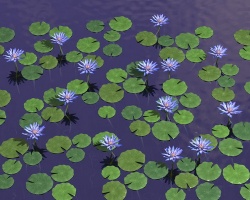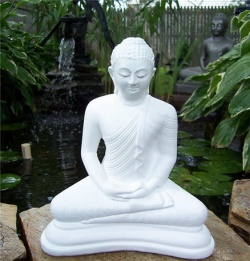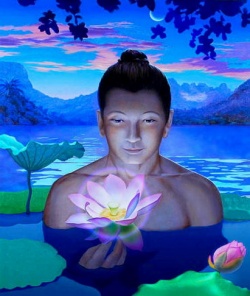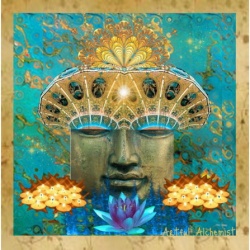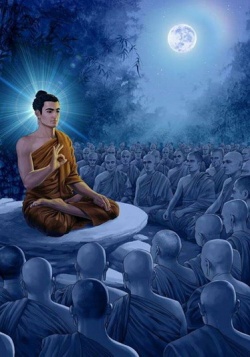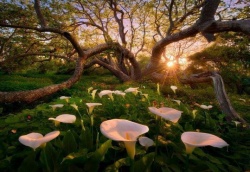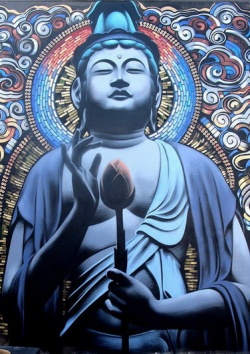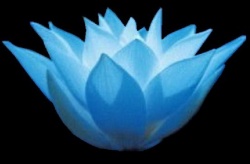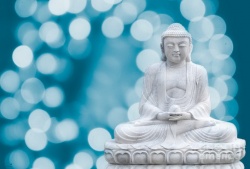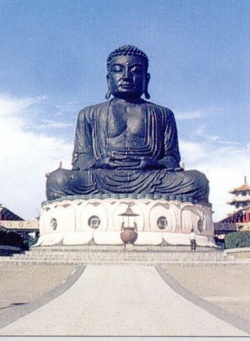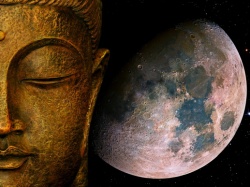Blue lotus
The blue lotus flower refers to the common sense; it uses wisdom and logic to create enlightenment. The blue lotus symbolizes the control of the spirit over one’s material senses. It also symbolizes knowledge, wisdom and intelligence. The blue lotus is always depicted only partially opened—perhaps to symbolize that knowledge should never be finished blooming. In a similar vein, its center is never seen. The blue lotus is the lotus associated with Manjusri, and is also one of the attributes of Prajnaparamita, the embodiment of the perfection of wisdom. This is a symbol of the victory of the spirit over the senses, and signifies the wisdom of knowledge. Not surprisingly, it is the preferred flower of Manjushri, the bodhisattva of wisdom.
The lotus has long been regarded as sacred by many of the world’s religions, especially in India and Egypt, where it is held to be a symbol of the Universe itself. Rooted in the mud, the lotus rises to blossom clean and bright, symbolizing purity and resurrection. The leaves and flowers are borne high above the water. It is often compared to the enlightened being who emerges undefiled from the chaos and confusion of the world.
In India, the Hindus hold the lotus seed to be especially sacred because the seed contains perfectly formed leaves, providing a complete template for the adult plant. This is believed to be Divine form passing from the abstract into tangible reality. The eight-petaled lotus used in Buddhist mandalas speaks to cosmic harmony. The thousand-petaled lotus represents spiritual illumination.
In Egypt, not a monument in the valley of the Nile, not a single papyrus scroll is without this plant in an honored place. On the capitals of the Egyptian pillars, on the thrones and even headdresses of the Divine Kings, the lotus appears everywhere.
The Blue Lotus in Buddhism is the symbol of the victory of the spirit over the senses, of intelligence and wisdom, of knowledge. It is generally represented as a partially opened bud, whose center is unseen, the embodiment of the “perfection of wisdom”. The Blue Lotus of the Nile was the most sacred of plants, prized above all others. The plant was associated with the sun god Ra as the bringer of light.
In the various traditions of India, the Blue Lotus has many treasured and sacred meanings. In “Cosmic Chants” by Paramahansa Yogananda, it is spoken of in reference to his beautiful chant “Blue Lotus Feet”:
“God in the aspect of Divine Mother is frequently depicted as sitting or standing on a large lotus, a symbol of purity and wisdom, hence a symbol of the Christ (Kutastha) intelligence, the ‘only-begotten’ reflected intelligence of God the Father in creation. Kutastha Intelligence initiates and guides all the activities of Cosmic Nature, the active principle or vibratory power of God manifesting in His creation. ‘Blue lotus feet’ poetically suggests Her origin in the Kutastha Intelligence, which is associated with the color blue. Aum, Holy Ghost, Cosmic Nature are all symbolic names of the Divine Mother.
The legend of the Blue Lotus
By H. P. Blavatsky
The title of every magazine or book should have some meaning, and especially should this be the case with a Theosophical publication. A title is supposed to express the object in view, symbolising, as it were, the content of the paper. Since allegory is the soul of Eastern philosophy, it may be objected that nothing can be seen in the name "Le Lotus Bleu," save that of a water plant — the Nymphea Cerulea or Nelumbo. Furthermore a reader of this calibre would see but the blue colour of the list of contents of our journal.
To avoid a like misunderstanding, we shall attempt to initiate our readers into the general symbolism of the lotus and the particular symbolism of the Blue Lotus. This mysterious and sacred plant has been considered through the ages, both in Egypt and in India, as a symbol of the Universe. Not a monument in the valley of the Nile, not a papyrus, without this plant in an honoured place. On the capitals of the Egyptian pillars, on the thrones and even the head-dresses of the Divine Kings, the lotus is everywhere found as a symbol of the Universe. It inevitably became an indispensable attribute of every creative god, as of every creative goddess, the latter being, philosophically considered, only the feminine aspect of the god, at first androgynous, afterwards male.
It is from Padma-Yoni, "the bosom of the Lotus," from Absolute Space, or from the Universe outside time and space, that emanates the Cosmos, conditioned and limited by time and space. The Hiranya Garbha, "the egg" (or the womb) of gold, from which Brahma emerges, is often called the Heavenly Lotus. The God, Vishnu, — the synthesis of the Trimurti or Hindu Trinity — during the "nights of Brahma" floats asleep on the primordial waters, stretched on the blossom of a lotus. His Goddess, the lovely Lakshmi, rising from the bosom of the waters, like Venus-Aphrodite, has a white lotus beneath her feet. It was at the churning of the Ocean of Milk — symbol of space and of the Milky Way — by the Gods assembled together, that Lakshmi, Goddess of Beauty and Mother of Love (Kama) formed of the froth of the foaming waves, appeared before the astonished Gods, borne on a lotus, and holding another lotus in her hand.
Thus have arisen the two chief titles of Lakshmi; Padma the Lotus, and Kshirabdi-tanaya daughter of the Ocean of Milk. Gautama the Buddha has never been degraded to the level of a god, notwithstanding the fact that he was the first mortal within historical times fearless enough to interrogate that dumb Sphinx, which we call the Universe, and to wrest completely therefrom the secrets of Life and Death. Though he has never been deified, we repeat, yet he has nevertheless been recognised by generations in Asia as Lord of the Universe. This is why the conqueror and master of the world of thought and philosophy is represented as seated on a lotus in full bloom, emblem of the Universe thought out by him. In India and Ceylon the lotus is generally of a golden hue; amongst the Buddhists of the North, it is blue.
But there exists in one part of the world a third kind of lotus — the Zizyphus. He who eats of it forgets of his fatherland and those who are dear to him, so say the ancients. Let us not follow this example. Let us not forget our spiritual home, the cradle of the human race, and the birthplace of the Blue Lotus.
Let us then raise the veil of oblivion which covers one of the most ancient allegories — a Vedic legend which, however, the Brahman chroniclers have preserved. Only as the chroniclers have recounted the legend each after his own manner, aided by variations* of his own, we have given the story here — not according to the incomplete renderings and translations of these Eastern gentlemen but according to the popular version. (* Cf. the history of Sunahsepha in the Bhagavata, IX, XVI, 35 and of the Ramayana, Bk. I. Cap. 60; Manu, X, 105;
Koulouka Bhatta [the Historian]; Bahwruba and the Aitareya Brahmanas; Vishnu Purana, etc., etc. Each book gives its own version.) Thus is it that the old bards of Rajasthan sing it, when they come and seat themselves in the verandah of the traveller's bungalow in the wet evenings of the rainy season. Let us leave then the Orientalists to their fantastic speculations. How does it concern us whether the father of the selfish and cowardly prince, who was the cause of the transformation of the white lotus into the blue lotus, be
called Harischandra or Ambarisha? Names have nothing to do with the naive poetry of the legend, nor with its moral — for there is a moral to be found if looked for well. We shall soon see that the chief episode in the story is curiously reminiscent of another legend — that of the story of Abraham and the sacrifice of Isaac in the Bible. Is not this one more proof that the Secret Doctrine of the East may have good reason to maintain that the name of the Patriarch was neither a Chaldean or a Hebrew name, but rather an epithet and a
Sanskrit surname, signifying abram, i.e., one is non-Brahman,* a debrahmanised Brahman, one who is degraded or who has lost his caste? After this how can we avoid suspecting that we may find, among the modern Jews, the Chaldeans of the time of the Rishi Agastya — these makers of bricks whose persecution began from eight hundred to a thousand years ago, but who emigrated to Chaldea four thousand years before the Christian era — when so many of the popular legends of Southern India resemble the Bible stories. Louis Jacolliot speaks in several of his twenty-one volumes on Brahmanical India of this matter, and for once he is right.
* The particle a in the Sanskrit word shews this clearly. Placed before a substantive this particle always means the negation or the opposite of the meaning of the expression that follows. Thus Sura (god) written a-Sura, becomes non-God, or the devil, Vidya is knowledge, and a-Vidya, ignorance or the opposite of knowledge, etc., etc.
We will speak of it another time. Meanwhile here is the Legend of
THE BLUE LOTUS
Century after century has passed away since Ambarisha, King of Ayodhya, reigned in the city founded by the holy Manu, Vaivasvata, the offspring of the Sun. The King was a Suryavansi (a descendant of the Solar Race), and he avowed himself a most faithful servant of the God, Varuna, the greatest and most powerful deity in the Rig-Veda.* But the god had denied male heirs to his worshipper, and this made the king very unhappy.
* It is only much later in the orthodox Pantheon and the symbolical polytheism of the Brahmans that Varuna became Poseidon or Neptune — which he is now. In the Vedas he is the most ancient of the Gods, identical with Ouranos of the Greek, that is to say a personification of the celestial space and the infinite gods, the creator and ruler of heaven and earth, the King, the Father and the Master of the world, of gods and of men. Hesiod's Uranus and the Greek Zeus are one.
"Alas!" he wailed, every morning while performing his puja to the lesser gods, "alas! What avails it to be the greatest king on earth when God denies me an heir of my blood. When I am dead and placed on the funeral pyre, who will fulfil the pious duties of a son, and shatter my lifeless skull to liberate my soul from its earthly trammels? What strange hand will at the full moon-tide place the rice of the Shraddha ceremony to do reverence to my shade? Will not the very birds of death [Rooks and ravens] themselves turn from the funeral feast? For, surely, my shade earthbound in its great despair will not permit them to partake of it."
* The Shradda is a ceremony observed by the nearest relatives of the deceased for the nine days following the death. Once upon a time it was a magical ceremony. Now, however, in addition to other practices, it mainly consists of scattering balls of cooked rice before the door of the dead man's house. If the crows promptly eat the rice it is a sign that the soul is liberated and at rest. If these birds which are so greedy did not touch the food, it was a proof that the pisacha or bhut (shade) is present and is preventing them. Undoubtedly the Shradda is a superstition, but certainly not more so than Novenas or masses for the Dead.
The King was thus bewailing, when his family priest inspired him with the idea of making a vow. If God should send him two or more sons, he would promise God to sacrifice to Him at a public ceremony the eldest born when he should have attained the age of puberty.
Attracted by this promise of a burnt-offering of flesh — a savory odour very agreeable to the Great Gods — Varuna accepted the promise of the King, and the happy Ambarisha had a son, followed by several others. The eldest son, the heir to the throne for the time being, was called Rohita (the red) and was surnamed Devarata — which, literally translated, means God-given. Devarata grew up and soon became a veritable Prince Charming, but if we are to believe the legends he was as selfish and deceitful as he was beautiful.
When the Prince had attained the appointed age, the God speaking through the mouth of the same Court Priest, charged the King to keep his promise; but when each time Ambarisha invented some excuse to postpone the hour of sacrifice, the God at last grew annoyed. Being a jealous and angry God, he threatened the King with all His Divine wrath.
For a long time, neither commands nor threats produced the desired effect. As long as there were sacred cows to be transferred from the royal cowsheds to those of the Brahmans, as long as there was money in the Treasury to fill the Temple crypts, the Brahmans succeeded in keeping Varuna quiet. But when there were no more cows, when there was no more money, the God threatened to overthrow the King, his palace and his heirs, and if they escaped, to burn them alive. The poor King, finding himself at the end of his resources, summoned his first-born and informed him of the fate which awaited him. But Devarata lent a deaf ear to these tidings. He refused to submit to the double weight of the paternal and divine will.
So, when the sacrificial fires had been lighted and all the good towns-folk of Ayodhya had gathered together, full of emotion, the heir-apparent was absent from the festival.
He had concealed himself in the forests of the Yogis.
Now, these forests had been inhabited by holy hermits, and Devarata knew that there he would be unassailable and impregnable. He might be seen there, but no one could do him violence — not even the God Varuna Himself. It was a simple solution. The religious austerities of the Aranyakas (the holy men of the forests) several of whom were Daityas (Titans, a race of giants and demons), gave them such dominance that all the Gods trembled before their sway and their supernatural powers — even Varuna, himself.
These antediluvian Yogis, it seems, had the power to destroy even the God Himself, at will — possibly because they had invented Him themselves.
Devarata spent several years in the forests; at last he grew tired of the life. Allowing it to be understood that he could satisfy Varuna by finding a substitute, who would sacrifice himself in his place, provided that the sacrificial victim was the son of a Rishi, he started on his journey and finally discovered that he sought.
In the country which lies around the flower-covered shores of the renowned Pushkara, there was once a famine, and a very holy man, named Ajigarta,* was at the point of death from starvation, likewise all his family. He had several sons of whom the second, Sunahsepha, a virtuous young man, was himself also preparing to become a Rishi. Taking advantage of his poverty and thinking with good reason that a hungry stomach would be a more ready listener than a satisfied one, the crafty Devarata made the father acquainted with his history. After this he offered him a hundred cows in exchange for Sunahsepha, a substitute burnt-offering on the altar of the Gods.
* Others call him Rishika and call King Ambarisha, Harischandra, the famous sovereign who was a paragon of all the virtues.
The virtuous father refused at first point-blank, but the gentle Sunahsepha offered himself of his own accord, and thus addressed his father: "Of what importance is the life of one man, when it can save that of many others. This God is a great god and His pity is infinite; but He is also a very jealous god and His wrath is swift and vengeful. Varuna is the Lord of Terror, and Death is obedient to His command. His spirit will not for ever strive with one who is disobedient to Him. He will repent Him that He has created man, and then will burn
alive a hundred thousand lakhs* of innocent people (*A lakh is a measure of 100,000, whether men or pieces of money be in question.), because of one man who is guilty. If His victim should escape Him, He will surely dry up our rivers, set fire to our lands and destroy our women who are with child — in His infinite kindness. Let me then sacrifice myself, oh! my father, in place of this stranger who offers us a hundred cows. That sum would prevent thee and my brothers from dying of hunger and will save thousands of others from a terrible death. At this price the giving up of life is a pleasant thing."
The aged Rishi shed some tears, but he ended by giving his consent and began to prepare the sacrificial pyre.*
*Manu (Book X, 105) alluding to this story remarks that Ajigarta, the holy Rishi, committed no sin in selling the life of his son, since the sacrifice preserved his life and that of all the family. This reminds us of another legend, more modern, that might serve as a parallel to the older one. Did not the Count Ugolino, condemned to die of starvation in his dungeon, eat his own children "to preserve for them a father"? The popular legend of Sunahsepha is more beautiful than the commentary of Manu — evidently an interpolation of some Brahmans in falsified manuscripts.
The Pushkara lake* was one of the spots of this earth favoured by the Goddess, Lakshmi-Padma (White Lotus); she often plunged into the fresh waters that she might visit her eldest sister, Varuni, the consort of the God Varuna.** Lakshmi-Padma heard the proposal of Devarata, witnessed the despair of the father, and admired the filial devotion of Sunahsepha. Filled with pity, the Mother of Love and Compassion sent for the Rishi Visvamitra, one of the seven primordial Manus and a son of Brahma, and succeeded in interesting him in the lot of her protege. The great Rishi promised her his aid. Appearing to Sunahsepha, but unseen by all others, he taught him two sacred
verses (mantras) of the Rig-Veda, making him promise to recite these on the pyre. Now, he who utters these two mantras (invocations) forces the whole assembly of the Gods, with Indra at their head, to come to his rescue, and because of this becomes a Rishi himself in this life or in his next incarnation.
* This lake is sometimes called in our day Pokker. It is I place famous for a yearly pilgrimage, and is charmingly situated five English miles from Ajmeer in Rajisthan. Pushkara means "the Blue Lotus", the surface of the lake being covered as with a carpet with these beautiful plants. But the legend avers that they were at first white. Pushkara is also the proper name of a man, and the name of one of the seven sacred islands" in the Geography of the Hindus, the septa dwipa.
** Varuni, Goddess of Heat (later Goddess of Wine) was also born of the Ocean of Milk. Of the "fourteen precious objects" produced by the churning, she appeared the second and Lakshmi the last, preceded by the Chalice of Anmita, the nectar which gives immortality.
The altar was set up on the shore of the lake, the pyre was prepared and the crowd had assembled. After he had laid his son on the perfumed sandal wood and bound him, Ajigarta equipped himself with the knife of sacrifice. He was just raising his trembling arm above the heart of his well-beloved son, when the boy began to chant the sacred verses. There was again a moment of hesitation and supreme grief, and as the boy finished his mantram, the aged Rishi plunged his knife into the breast of Sunahsepha.
But, oh! the miracle of it! At that very moment Indra, the God of the Blue Vault (the Universe) issued from the heavens and descended right into the midst of the ceremony. Enveloping the pyre and the victim in a thick blue mist, he loosed the ropes which held the youth captive. It seemed as if a corner of the azure heavens had lowered itself over the spot, illuminating the whole country and colouring with a golden blue the whole scene. Filled with terror, the crowd, and even the Rishi himself, fell on their faces, half dead with fear.
When they came to themselves, the mist had disappeared and a complete change of scene had been wrought.
The fires of the funeral pyre had rekindled of themselves, and stretched thereon was seen a hind (Rohit)* which was none else than the Prince Rohita, Devarata, who, pierced to the heart with the knife he had directed against another, was burning as a sacrifice for his sin.
* A play upon words. Rohit in Sanskrit is the Dame of the female of the deer, the hind, and Rohita means "red". It was because of his cowardice and fear of death that he was changed, according to the legend, into a hind by the Gods.
Some little way apart from the altar, also lying stretched out, but on a bed of Lotuses, peacefully slept Sunahsepha; and in the place on his breast where the knife had descended was seen to bloom a beautiful blue lotus. The Pushkara lake, itself, covered a moment before with white lotuses, whose petals shone in the sun like silver cups full of Amrita's waters [The Elixir which confers Immortality.], now reflected the azure of the heavens — the white lotuses had become blue.
Then like to the sound of the Vina [A species of the Lute. An instrument, the invention of which is attributed to Shiva.] rising to the air from the depth of the waters, was heard a melodious voice which uttered these words and this curse:
"A prince who does not know how to die for his subjects is not worthy to reign over the children of the Sun. He will be reborn in a race of red haired peoples, a barbarous and selfish race, and the nations which descend from him will have a heritage ever on the decline. It is the younger son of a mendicant ascetic who will become the King and reign in his stead."
A murmur of approbation set in movement the flowery carpet that overspread the lake. Opening to the golden sunlight their hearts of blue, the lotuses smiled with joy and wafted a hymn of perfume to Surya, their Sun and Master. All nature rejoiced, save Devarata, who was but a handful of ashes.
Then Visvamitra, the great Rishi, although he was already the father of a hundred sons, adopted Sunahsepha as his eldest son and as a precautionary measure cursed in advance anyone who should refuse to recognise, in the last born of the Rishi, the eldest of his children and the legitimate heir of the throne of Ambarisha.
Because of this decree, Sunahsepha was born in his next incarnation in the royal family of Ayodha and reigned over the Solar race for 84,000 years.
With regard to Rohita — Devarata or God-given as he was — he fulfilled the lot which Lakshmi Padma had vowed. He reincarnated in the family of a foreigner without caste (Mleccha-Yavana) and became the ancestor of the barbarous and red-haired races which dwell in the West.
- * * * *
It is for the conversion of these races that the Lotus Bleu has been established.
If any of our readers should allow themselves to doubt the historical truth of this adventure of our ancestor; Rohita, and of the transformation of the white lotus into the blue lotus, they are invited to make a journey to Ajmeer.
Once there, they need only to go to the shores of the lake thrice blessed, named Pushkara, where every pilgrim who bathes during the full moon time of the month of Krhktika (October-November) attains to the highest sanctity, without other effort. There the sceptics would see with their own eyes the site where was built the pyre of Rohita, and also the waters visited by Lakshmi in days of yore.
They might even have seen the blue lotuses, if most of these had not since been changed, thanks to a new transformation decreed by the Gods, into sacred crocodiles which no one has the right to disturb. It is this transformation which gives to nine out of every ten pilgrims who plunge into the waters of the lake, the opportunity of entering into Nirvana almost immediately, and also causes the holy crocodiles to be the most bulky of their kind.
